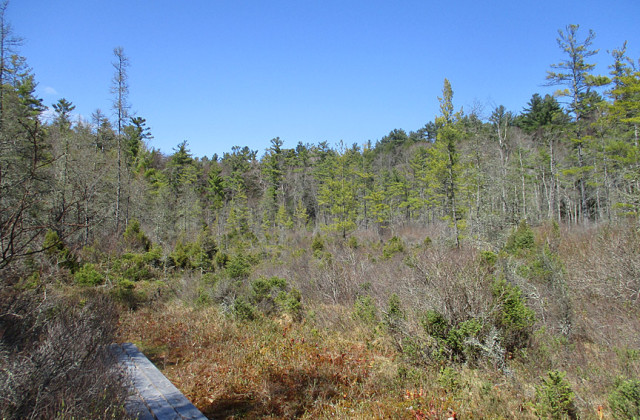Tobey Bog: The Centrality of Marginal Places
By Hans M. Carlson
Many of the articles I’ve written for Norfolk Now have concerned the interconnectedness of the natural world and human communities. By highlighting stone walls, collier’s hearths and the remnants of early conservation work, I’ve tried to show that even the deepest woods here in the northwest corner of Conn. are part of a deeply historical landscape—a natural record of the good and bad decisions we’ve made in working the land.
Conservation and forest management are predicated on valuing human participation, and thinking historically is important in judging that participation. Yet writing last month about the geological and glacial underpinnings of that history, I was reminded that there are also places that, while not isolated from history, have remained at its fringes. Tobey Bog is one of those places in my mind—consciously left alone, and so lightly touched that you can almost imagine a time before people arrived in this corner of the world.
The bog’s five acres are surrounded by Great Mountain Forest’s “North Forty” area, just northwest of Tobey Pond. Here the glacial processes I described last month created a kettle, which then became what’s known as a minerotrophic peatland. This means that while the bog is completely closed to aboveground hydrology—streams or floodplains—it likely gets nutrient-rich seepage from groundwater. Traveling through the ground, water picks up minerals from eroding rocks and soil particles, and delivers them into this mostly closed system.
These kinds of bogs occur in southern New England—Beckley Bog is another local example—and are different from the ombrotrophic bogs which are completely isolated from everything except rain or snowmelt. These only occur from Maine northwards, where cooler temperatures restrict the loss of water from surface evaporation, and underlying geology cuts off all inflow. In warmer areas, these have long since dried up. In order to continue accumulating slowly decomposing peat, all bogs must gain what little water they get at a faster rate than they lose from evaporation and plant respiration, and this is why there are so few true bogs in southern New England, and we are lucky to have two so close at hand.
Peat is the key to bog ecology, and is created when overall plant production is greater than the system’s ability to fully decompose organic matter. The weight of new vegetation presses partially decayed matter down deep below the surface and this, combined with hydrological isolation, creates the highly acidic conditions that make bog ecology so unique. Peat shapes the chemistry, and is also a deep physical structure, with Sphagnum moss tending to be the bulk of the floating mat. All the life in the bog floats on this buoyant layer and is adapted to the harsh chemistry.
The wooden walkway which extends 100-feet into the center of Tobey Bog also floats on this mossy structure, crossing the subtle transition from forest to wetland. It begins in dense patches of highbush blueberry and invasive glossy buckthorn, as well as bog and fragile fern, then turning the corner, the bog opens and the whole interior is scattered with stunted trees—red maple, larch, white pine and black spruce.
The latter are particularly notable as they are a boreal species usually found much farther north. This gives the area a distinctly subarctic feel, connecting it to the north, which has also historically been on the margins of human activity. Vast portions of the Canadian Shield are known generically as muskeg, an Algonquian term meaning “grassy bog,” and have also been largely ignored, until recently, by all but the Native inhabitants.
Despite its ecological fragility, Tobey Bog is protected by the forest. It is not in danger of development, nor is it threatened by nutrient addition from nearby septic fields and surface fertilizers, like numerous other wetlands. Yet, it will be especially vulnerable to climate change, like all peatlands, as warming temperatures increase decomposition rates and evaporation.
Globally, the boreal region holds a vast biomass stored in various peatlands, and their synchronized decomposition, due to warming, will release many tons of sequestered carbon. This will exacerbate the greenhouse effect, and put all these places front and center. We will continue to leave Tobey Bog to its own processes and life cycles, preserving it as a rarity in Southern New England, but it is no longer a place on the margins of our choices.
Photo by Hans M. Carlson.

